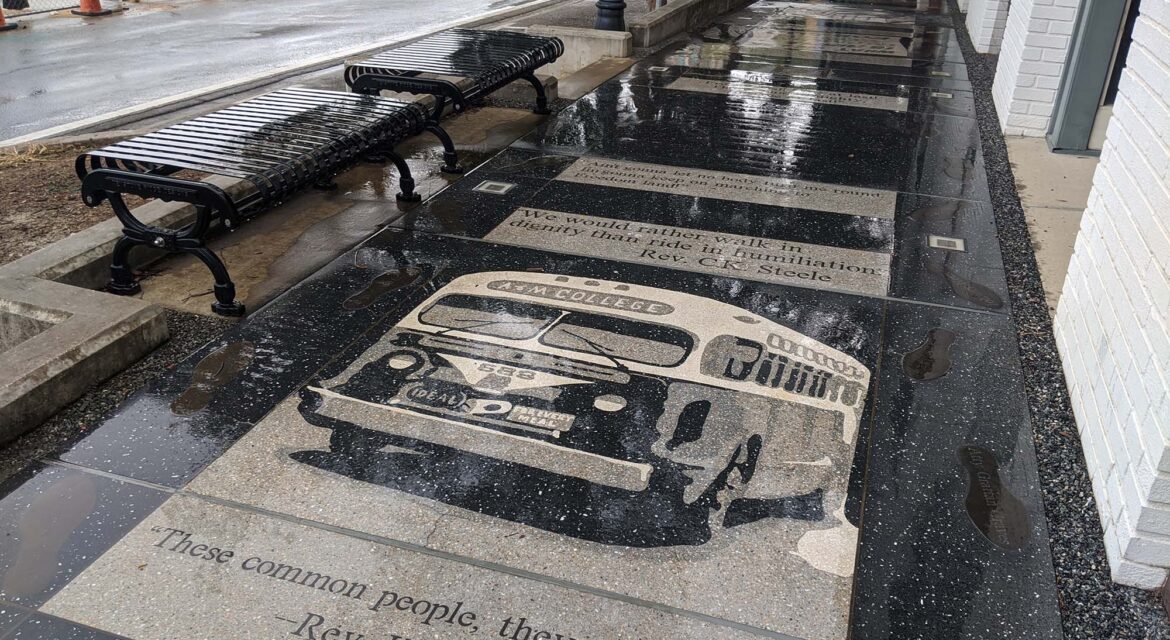 Located on a street corner in Tallahassee, Florida, the Civil Rights Heritage Walk has transformed what would otherwise be a plain sidewalk into a monument that tells the story of an essential element of the history of the city. In doing so, it highlights what it can look like to create a monument in an otherwise non-descript space that attracts the attention of both residents and visitors.
Located on a street corner in Tallahassee, Florida, the Civil Rights Heritage Walk has transformed what would otherwise be a plain sidewalk into a monument that tells the story of an essential element of the history of the city. In doing so, it highlights what it can look like to create a monument in an otherwise non-descript space that attracts the attention of both residents and visitors.
Honoring the Tallahassee Bus Boycott of 1956
Officially known as the Tallahassee-Leon County Civil Rights Heritage Walk, the multiple panels tells the story of the Tallahassee bus boycott as well as and the lunch counter sit-in demonstrations of 1960-1963. The Tallahassee bus boycott was a citywide boycott that sought to end racial segregation in the employment and seating arrangements of city buses.
 Considered to be the second major bus boycott in the United States, the Civil Rights Heritage Walk honors more than 50 civil rights activists, also known as foot soldiers, by highlighting their names, stories and contributions. The monument was unveiled in 2013 by the Tallahassee Community Redevelopment Agency (CRA), the City of Tallahassee and Leon County Government. Many are honored with their name on an embedded brass footprint, with individuals like Stephen Due and Rev. Dr. Charles Kenzie (C.K.) Steele specifically highlighted.
Considered to be the second major bus boycott in the United States, the Civil Rights Heritage Walk honors more than 50 civil rights activists, also known as foot soldiers, by highlighting their names, stories and contributions. The monument was unveiled in 2013 by the Tallahassee Community Redevelopment Agency (CRA), the City of Tallahassee and Leon County Government. Many are honored with their name on an embedded brass footprint, with individuals like Stephen Due and Rev. Dr. Charles Kenzie (C.K.) Steele specifically highlighted.
Maps and markers throughout Tallahassee call out the location of the Civil Rights Heritage Walk, illustrating what kind of an impact it has enabled for the community. It has become an attraction that embraces the past to mean something to audiences in the present and future.

From Sidewalk to Monument
 Even though it is only comprised of 16 terrazzo panels and only half a block long, the Civil Rights Heritage Walk has nonetheless been highlighted as the one downtown Tallahassee block that everyone should walk. In utilizing such a small and common space to become an essential element of the community in more ways than one, the Civil Rights Heritage Walk highlights both what it can mean to transform what would otherwise be an empty area into an attraction that celebrates the history of a community in an especially creative manner.
Even though it is only comprised of 16 terrazzo panels and only half a block long, the Civil Rights Heritage Walk has nonetheless been highlighted as the one downtown Tallahassee block that everyone should walk. In utilizing such a small and common space to become an essential element of the community in more ways than one, the Civil Rights Heritage Walk highlights both what it can mean to transform what would otherwise be an empty area into an attraction that celebrates the history of a community in an especially creative manner.


